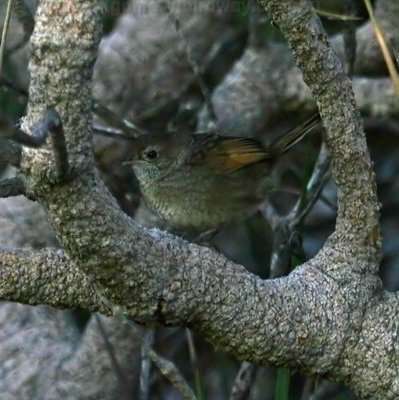Dasyornithidae – Bristlebirds

The bristlebirds Dasyornithidaeare a family of passerine birds. There are three species in one genus, Dasyornis. The family is endemic to Australia. The genus Dasyornis was sometimes placed in the Acanthizidae or, as a subfamily, Dasyornithinae, along with the Acanthizinae and Pardalotinae, within an expanded Pardalotidae, before being elevated to full family level by Christidis & Boles (2008). DNA sequencing revealed that the three species were not as closely related to other Australian endemics as first thought.
Bristlebirds are long-tailed, sedentary, ground-frequenting birds. They vary in length from about 17 cm to 27 cm, with the eastern bristlebird being the smallest, and the rufous bristlebird the largest. Their colouring is mainly grey with various shades of brown, ranging from olive-brown through chestnut and rufous, on the plumage of the upperparts. The grey plumage of the underparts or the mantle is marked by pale dappling or scalloping. The common name of the family is derived from the presence of prominent rictal bristles.
Bristlebirds have restricted, and often reduced and disjunct, ranges along the coasts of south-western and south-eastern Australia where there is a Mediterranean climate and suitable habitat of coastal scrubs, heathlands and dense under-storey vegetation in woodlands and forests. The Eastern Bristlebird occurs in threatened, localised and disjunct populations down the eastern Australian coast from south-east Queensland through New South Wales to eastern Victoria; the Rufous Bristlebird in western Victoria and south-eastern South Australia, and formerly in south-western Western Australia; with the Western Bristlebird occurring in a small area of south-west Western Australia.
Bristlebirds are generally shy diurnal birds that skulk in dense vegetation. They preferentially run to avoid danger, but are capable of flying short distances. They generally occur in pairs, but their social structure has not been studied closely. They are more usually heard than seen, although it is usually the male that sings. The song is loud, melodic and can carry for some distances. The song is thought to be territorial in nature and is often made from on top of a log or shrub to better carry in the air.
Most of the food is found by foraging on the ground. Birds forage in pairs, making small contact calls to keep in touch, and constantly flicking their tails whilst moving. The major part of the diet is composed of insects and seeds. Spiders and worms are also taken, and birds have been observed drinking nectar as well.
Their breeding behaviour is poorly known. They are thought to mostly be monogamous and defend a territory against others of the same species. The nest is constructed by the female in low vegetation and is a large ovoid dome with a side entrance. Two dull eggs are laid. As far as is known only the female incubates the clutch, for a period of between sixteen and twenty-one days. The nestling stage is known to be long, eighteen to twenty-one days
The three species are:
Eastern Bristlebird Dasyornis brachypterus
Western Bristlebird Dasyornis longirostris
Rufous Bristlebird Dasyornis broadbenti
-
Eastern Bristlebird Dasyornis brachypterus
IUCN Species Status8-22 cm. Medium-sized, sturdy, grey-brown passerine. Sexes similar, female slightly smaller. Dark cinnamon-brown upperparts. Rufous-brown upperwing and uppertail. Grey-brown underparts, faintly scalloped. Grey-brown sides of belly and flanks. Brown undertail-coverts. Dull rufous-brown undertail. Red iris. Juvenile, pale brown iris. -
Eastern Bristlebird Dasyornis brachypterus
Species AccountSound archive and distribution map -
Rufous Bristlebird Dasyornis broadbenti
IUCN Species StatusThis taxon is endemic to Australia. Nominate broadbenti occurs in near-coastal environments from Port Fairy, Victoria, to the mouth of the Murray River, South Australia. Subspecies caryochrous was thought to be largely confined to the coast between Peterborough and Point Addis east of Anglesea, Western Victoria, but is now known to occur extensively within the Otway Range. Subspecies litoralis, endemic to Western Australia, is extinct, probably as a result of fire, and was last seen in 1940 (Glauert 1944). -
Rufous Bristlebird Dasyornis broadbenti
Species AccountSound archive and distribution map -
Rufous Bristlebird Dasyornis broadbenti
Species AccountThe rufous bristlebird (Dasyornis broadbenti) is one of three extant species of bristlebirds. It is endemic to Australia where three subspecies have been described from coastal southwestern Western Australia, southeastern South Australia and southwestern Victoria. Its natural habitat is coastal shrublands and heathlands. It is threatened by habitat destruction. -
Western Bristlebird Dasyornis longirostris
IUCN Species Status17-20 cm. Medium-sized, sturdy, grey-brown passerine. Sexes similar. Dark brown upper back dappled pale grey. Dark brown lower back. Rich rufous-brown rump. Rufous-brown upperwing-coverts. Mostly rufous-brown uppertail. Off-white centre of breast and belly with fine black-brown scalloping, sparser on belly. Olive-brown sides of belly and flanks with fine black-brown scalloping. Mostly olive-brown undertail. Juvenile similar to adult, but upperparts without dappling. -
Western Bristlebird Dasyornis longirostris
Species AccountSound archive and distribution map
-
Number of bird species: 3
